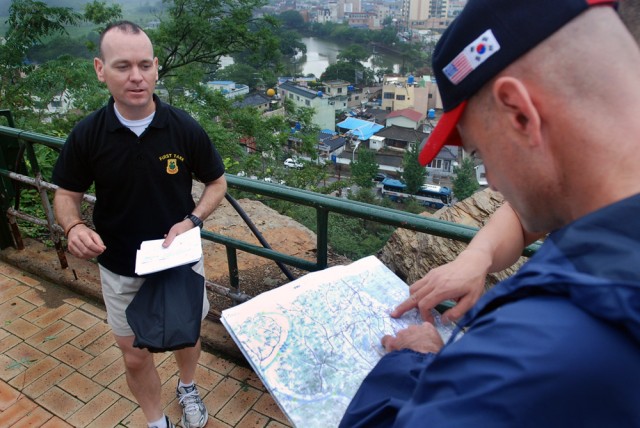SEOUL - Key leaders of the 1st Heavy Brigade Combat Team, 2nd Infantry Division received valuable insights from a highly decorated retired Republic of Korea Army general as they completed a weeklong professional development event in July.
Paik Sun-yup, author of the book "From Pusan to Panmunjom" and a major figure of the Korean War, discussed his experiences with the HBCT leaders. Paik commanded at the division and corps levels, ultimately becoming Korea's first four-star general. Now 89 years old, Paik provided a detailed account of the events leading up to the war and of his time spent in command.
"Gen. Paik was extremely gracious, and it was an honor to have him speak to us today," Col. Thomas C. Graves, commander of the 1st HBCT, said after the talk. "Being able to have a discussion with him about what he saw, the things he did, and the lessons he learned was invaluable and an experience we will not soon forget."
Paik served as commander of Korea's 1st Infantry Division, assigned to the defense of Seoul when the war broke out June 25, 1950. His unit fell back, ultimately forming an important part of what became commonly known as the "Pusan Perimeter." Following the Inchon landing led by Gen. Douglas MacArthur and the turn of the tide of the war, Paik's Division was the first to enter Pyongyang Oct. 19, 1950. Paik's men subsequently assumed the defense of northwestern Korea until the Chinese entered the war.
Following the war, Paik helped transform the Korean military, serving as the commander of the First Field Army, ROKA chief of staff and chairman joint chiefs of staff until he retired in 1960.
"Being able to shake the hand of such an important figure of the war, a person who fought side-by-side with all the people I can only read about, was truly a great experience," said Maj. Dale Woodhouse, staff officer for the brigade.
Paik's brief was the final event of a week-long training event for the leadership of the "Iron Brigade." The "staff ride" also included a trip to the Demilitarized Zone and visits to many of the major battle sites of the Korean War, such as Chipeong-ri, the Naktong Bulge and Pusan Perimeter.
"It was a perfect opportunity to walk the ground that our predecessors had fought for and it gave us a new appreciation for the challenges they faced," said Woodhouse.
Each battle site was accompanied by a historical presentation of what occurred, followed by a discussion on what the leadership perspective likely was while the events were ongoing.
"The staff ride was important because it allowed the leaders of the brigade to see and discuss the actual ground where these battles were fought," said Graves. "The memorial sites served as a great backdrop to discuss some of the lessons of the Korean War and how we might use that information today."
Paik spoke to the commander and staff on the final day of the training event against the backdrop of Korea's National War Museum.
"The brief given by General Paik on our last day really drove home everything we discussed over the last few days," Graves said in summation. "It brought some perspective on the leadership decision-making that we discussed throughout the week."




Social Sharing